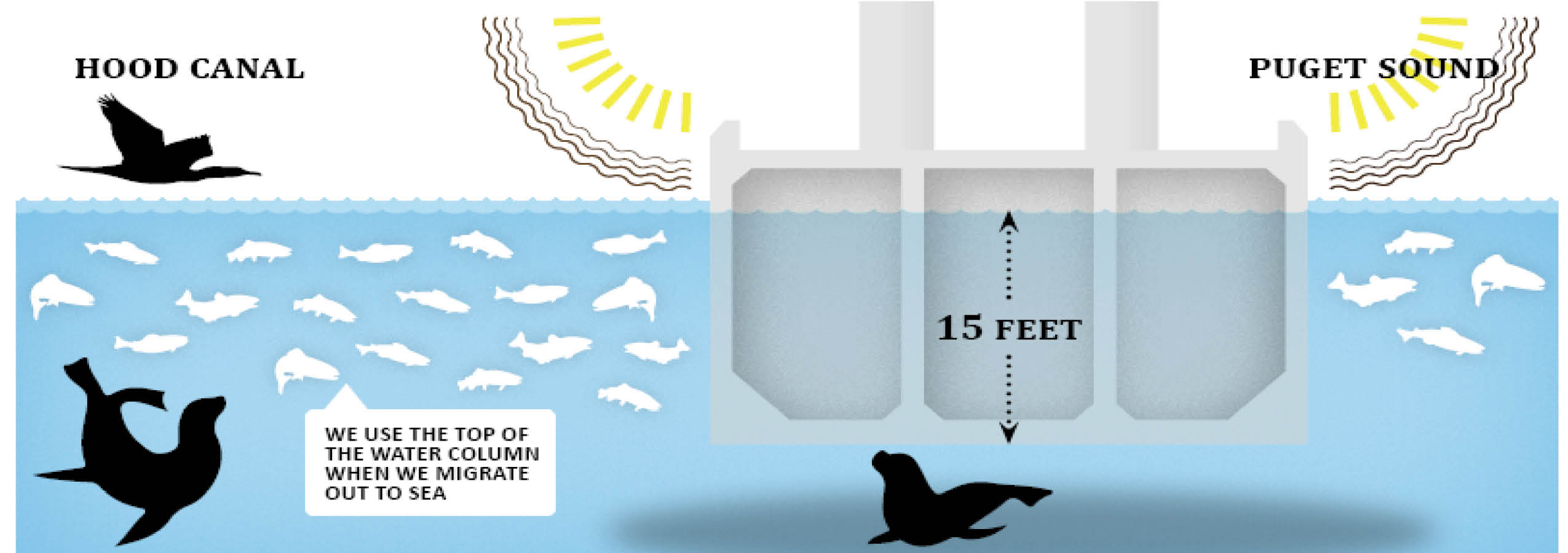Project Summary
The Hood Canal Bridge connects people and commerce between the Olympic Peninsula and the rest of Puget Sound. A floating bridge, its pontoons span 83% of the width of Hood Canal and extend 15 feet underwater. The bridge stands between the Pacific Ocean and thousands of acres of beautiful habitat for salmon, steelhead and shellfish where communities have invested millions to maintain and improve.
Long Live the Kings’ Hood Canal Steelhead Project results show 65% of juvenile, ESA-listed steelhead that reach the Hood Canal Bridge do not make it north to the Strait of Juan de Fuca, with strong evidence that the bridge is acting as migration barrier, driving this mortality. This level of mortality is alarming, and observations indicate that threatened Chinook and summer chum may also be affected.
Moreover, computer modeling suggests the bridge’s pontoons may reduce water circulation in and out of Hood Canal by 12%. While that number seems small, it could be enough to significantly impact the ecosystem and exacerbate issues like low dissolved oxygen and warm temperatures, threatening aquaculture, tourism, commercial and recreational fishing, and tribal treaty rights.
This project is supported by Jefferson, Mason and Kitsap Counties, local tribes, the state legislature, and constituents who have recognized the fisheries effects of the bridge for quite some time. Support from these key stakeholders has resulted in an effective, collaborative approach which balances the needs of the environment and local community. To this end, we plan to develop short and long term solutions to mitigate the impacts of the floating bridge while avoiding interference with the functionality of the bridge as a transposition corridor.

Image courtesy of Long Live the Kings.
This infographic shows how steelhead, using the top of the water column to migrate, must navigate the pontoons while avoiding predators, and dealing with light and noise from the bridge.
Left image courtesy of Hans Daubenberger, Port Gamble S’Klallam Tribe; Right image courtesy of the U.S. Navy.
Harbor seals are often seen using the bridge structure to help hunt fish lingering around the bridge. Additionally, Hood Canal contains over 200 miles of shoreline habitat where numerous rivers meet the saltwater. It is also home to Bangor Naval Base, the location of many of our nation’s ballistic missiles and nuclear submarines which also navigate the bridge as they head to the Pacific.
Congressional District: 6
Funding Sources:
The Hood Canal Bridge Assessment is made possible by state, federal and private funds including: Pacific Coast Salmon Recovery Fund, Port Gamble S’Klallam Tribe, NOAA, Hood Canal Coordinating Council, and Laird Norton Family Foundation. The state legislature provided $750,000 for this critical project in the 2017-2019 Washington State budget
Partners:
Long Live the Kings, National Oceanic and Atmospheric Administration, Pacific Northwest National Laboratory, U.S. Navy, Hood Canal Coordinating Council, Port Gamble S’Klallam Tribe, Washington Department of Fish and Wildlife, Washington State Department of Transportation



